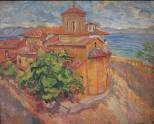Born in Uzice, Serbia in 1882, died in Belgrade (shot by the Partisans) in 1944. One of the most prominent Serbian artists. Studied at the Technical University Belgrade in 1905 and later at the Art Academy in Munich until 1909. His education continued in Paris between 1909-1912. He was a war painter in the period 1912-1918. In this role he visited Macedonia where he was wounded at the Battle for Kumanovo. Got a military promotion of lieutenant. After the Balkan wars he became an Art teacher at the Technical University in Belgrade. As a member of the Democratic Party and strong advocate of democracy, he was jailed in Banjica prison. Labeled as “national traitor” and shot by the communists in 1944. His grave is unknown.
Popović was in Macedonia during the Balkan wars and in the 1930s. One painting from Macedonia is Monastery St. Naum, Ohrid, oil on canvas, 1931.
